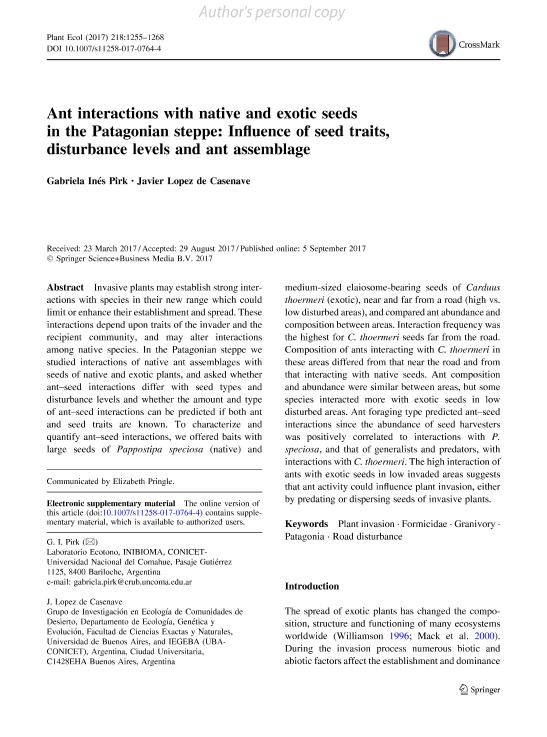Mostrar el registro sencillo del ítem
dc.contributor.author
Pirk, Gabriela Inés

dc.contributor.author
Lopez de Casenave, Javier Nestor

dc.date.available
2018-11-27T18:28:13Z
dc.date.issued
2017-12
dc.identifier.citation
Pirk, Gabriela Inés; Lopez de Casenave, Javier Nestor; Ant interactions with native and exotic seeds in the Patagonian steppe: Influence of seed traits, disturbance levels and ant assemblage; Springer; Plant Ecology; 218; 11-12; 12-2017; 1255-1268
dc.identifier.issn
1385-0237
dc.identifier.uri
http://hdl.handle.net/11336/65362
dc.description.abstract
Invasive plants may establish strong interactions with species in their new range which could limit or enhance their establishment and spread. These interactions depend upon traits of the invader and the recipient community, and may alter interactions among native species. In the Patagonian steppe we studied interactions of native ant assemblages with seeds of native and exotic plants, and asked whether ant–seed interactions differ with seed types and disturbance levels and whether the amount and type of ant–seed interactions can be predicted if both ant and seed traits are known. To characterize and quantify ant–seed interactions, we offered baits with large seeds of Pappostipa speciosa (native) and medium-sized elaiosome-bearing seeds of Carduus thoermeri (exotic), near and far from a road (high vs. low disturbed areas), and compared ant abundance and composition between areas. Interaction frequency was the highest for C. thoermeri seeds far from the road. Composition of ants interacting with C. thoermeri in these areas differed from that near the road and from that interacting with native seeds. Ant composition and abundance were similar between areas, but some species interacted more with exotic seeds in low disturbed areas. Ant foraging type predicted ant–seed interactions since the abundance of seed harvesters was positively correlated to interactions with P. speciosa, and that of generalists and predators, with interactions with C. thoermeri. The high interaction of ants with exotic seeds in low invaded areas suggests that ant activity could influence plant invasion, either by predating or dispersing seeds of invasive plants.
dc.format
application/pdf
dc.language.iso
eng
dc.publisher
Springer

dc.rights
info:eu-repo/semantics/openAccess
dc.rights.uri
https://creativecommons.org/licenses/by-nc-sa/2.5/ar/
dc.subject
Formicidae
dc.subject
Granivory
dc.subject
Patagonia
dc.subject
Plant Invasion
dc.subject
Road Disturbance
dc.subject.classification
Otras Ciencias Biológicas

dc.subject.classification
Ciencias Biológicas

dc.subject.classification
CIENCIAS NATURALES Y EXACTAS

dc.title
Ant interactions with native and exotic seeds in the Patagonian steppe: Influence of seed traits, disturbance levels and ant assemblage
dc.type
info:eu-repo/semantics/article
dc.type
info:ar-repo/semantics/artículo
dc.type
info:eu-repo/semantics/publishedVersion
dc.date.updated
2018-10-23T18:40:12Z
dc.journal.volume
218
dc.journal.number
11-12
dc.journal.pagination
1255-1268
dc.journal.pais
Alemania

dc.journal.ciudad
Berlin
dc.description.fil
Fil: Pirk, Gabriela Inés. Consejo Nacional de Investigaciones Científicas y Técnicas. Centro Científico Tecnológico Conicet - Patagonia Norte. Instituto de Investigaciones en Biodiversidad y Medioambiente. Universidad Nacional del Comahue. Centro Regional Universidad Bariloche. Instituto de Investigaciones en Biodiversidad y Medioambiente; Argentina
dc.description.fil
Fil: Lopez de Casenave, Javier Nestor. Consejo Nacional de Investigaciones Científicas y Técnicas. Oficina de Coordinación Administrativa Ciudad Universitaria. Instituto de Ecología, Genética y Evolución de Buenos Aires. Universidad de Buenos Aires. Facultad de Ciencias Exactas y Naturales. Instituto de Ecología, Genética y Evolución de Buenos Aires; Argentina. Universidad de Buenos Aires. Facultad de Ciencias Exactas y Naturales. Departamento de Ecología, Genética y Evolución; Argentina
dc.journal.title
Plant Ecology

dc.relation.alternativeid
info:eu-repo/semantics/altIdentifier/url/https://link.springer.com/article/10.1007/s11258-017-0764-4
dc.relation.alternativeid
info:eu-repo/semantics/altIdentifier/doi/https://dx.doi.org/10.1007/s11258-017-0764-4
Archivos asociados
